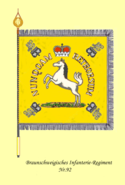Armia Cesarstwa Niemieckiego
| Gott Mit Uns | |
 Sztandar cesarza niemieckiego jako wodza naczelnego | |
| Historia | |
| Państwo | |
|---|---|
| Sformowanie | 1871 |
| Rozformowanie | 1919 |
| Tradycje | |
| Kontynuacja | |
Armia Cesarstwa Niemieckiego (niem. Deutsches Heer) – wojska lądowe Cesarstwa Niemieckiego w latach 1871–1919, pod zwierzchnictwem cesarza niemieckiego.
Składały się z czterech kontyngentów: pruskiego, obejmującego także mniejsze kraje Rzeszy, bawarskiego, saskiego i wirtemberskiego. Formalnie, mimo przejścia pod dowództwo pruskie, królowie tych trzech krajów zachowali pewną kontrolę nad wojskiem. Dotyczyło to zwłaszcza Bawarii. Żołnierze składali przysięgę na wierność cesarzowi, ale bawarskich wojskowych ta przysięga obowiązywała jedynie w czasie wojny, gdyż w czasie pokoju zwierzchnictwo nad armią bawarską sprawował król bawarski. Ponadto wojska bawarskie różniły się nieco umundurowaniem i istniały wyodrębnione korpusy bawarskie. W skład wojsk lądowych Cesarstwa Niemieckiego wchodziły także Siły powietrzne.
Podstawy prawne
Podstawami prawnymi funkcjonowania armii Cesarstwa były:
- 1. die Reichsverfassung (16 kwietnia 1871)
- 2. der Bündnisvertrag zwischen dem Norddeutschen Bund und Bayern (23 listopada 1870)
- 3. die Militärkonvention zwischen dem Norddeutschen Bund und Württemberg (21/25 listopada 1870)
- 4. die Konventionen zwischen Preußen und Sachsen (7 lutego 1867)
- 5. die Konventionen zwischen Preußen und den sonstigen Bundesstaaten
- 6. das Reichsmilitärgesetz (2 maja 1874)
Struktura organizacyjna
| Inspekcja | Miejsce stacjonowania | podległe korpusy armijne |
|---|---|---|
| I Inspekcja Armii | Hanower, od 1900 Berlin, od 1914 Gdańsk | 1871: I Korpus Armijny, II Korpus Armijny, IX Korpus Armijny, X Korpus Armijny od 1906: I Korpus Armijny, II Korpus Armijny, IX Korpus Armijny, X Korpus Armijny, XVII Korpus Armijny od 1914: I Korpus Armijny, II Korpus Armijny, XVII Korpus Armijny |
| II Inspekcja Armii | Drezno, od 1906 Meiningen, od 1914 Berlin | 1871: V Korpus Armijny, VI Korpus Armijny, XII Korpus Armijny od 1906: V Korpus Armijny, VI Korpus Armijny, XII Korpus Armijny, XIX Korpus Armijny od 1914: Korpus Gwardii, XII Korpus Armijny, XIX Korpus Armijny |
| III Inspekcja Armii | Darmstadt, od 1906 Hanower | 1871: VII Korpus Armijny, VIII Korpus Armijny, XI Korpus Armijny od 1906: VII Korpus Armijny, VIII Korpus Armijny, XI Korpus Armijny, XIII Korpus Armijny, XVIII Korpus Armijny od 1914: XIII Korpus Armijny, IX Korpus Armijny, X Korpus Armijny |
| IV Inspekcja Armii | Berlin, od 1906 Monachium | 1871: III Korpus Armijny, IV Korpus Armijny przydzielone: I Królewsko-Bawarski Korpus Armijny, II Królewsko-Bawarski Korpus Armijny od 1906: III Korpus Armijny, IV Korpus Armijny przydzielone: I Królewsko-Bawarski Korpus Armijny, II Królewsko-Bawarski Korpus Armijny od 1914: III Korpus Armijny przydzielone: I Królewsko-Bawarski Korpus Armijny, II Królewsko-Bawarski Korpus Armijny, III Królewsko-Bawarski Korpus Armijny |
| V Inspekcja Armii | Karlsruhe | 1871: XIV Korpus Armijny, XV Korpus Armijny od 1906: XIV Korpus Armijny, XV Korpus Armijny, XVI Korpus Armijny od 1914: XIII Korpus Armijny, IX Korpus Armijny, XV Korpus Armijny |
| od 1914 VI Inspekcja Armii | Stuttgart | IV Korpus Armijny, XI Korpus Armijny, XIII Korpus Armijny |
| od 1914 VII Inspekcja Armii | Saarbrücken | XVI Korpus Armijny, XVII Korpus Armijny, XXI Korpus Armijny |
| od 1914 VIII Inspekcja Armii | Berlin | VI Korpus Armijny, XI Korpus Armijny, XX Korpus Armijny, XVIII Korpus Armijny |
Liczebność armii
| Rok | 1875 | 1888 | 1891 | 1893 | 1899 | 1902 | 1906 | 1908 | 1911 | 1913 | 1914 |
|---|---|---|---|---|---|---|---|---|---|---|---|
| Liczba żołnierzy | 420 tys. | 487 tys. | 507 tys. | 580 tys. | 591 tys. | 605 tys. | 610 tys. | 613 tys. | 617 tys. | 663 tys. | 794 tys. |
Stopnie wojskowe
Naramienniki
Elementy umundurowania
Hełm pikielhauba
Czapka Krätzchen[1]
Sztandary
14 Pułk Artylerii Piechoty (Wielkoksiążęcy Badeński)
1 Batalion 92 Pułku Piechoty (Książęcy Brunszwicki)
93 Pułk Piechoty (Książęcy Anhalcki)
94 Pułk Piechoty (Wielkoksiążęcy Saski-Weimar-Eisenach)
168 Pułk Piechoty (5 Wielkoksiążęcy Heski)
103 Pułk Piechoty (4 Królewski Saski)
1 Batalion 1 Pułku Piechoty Gwardii (Królewski Pruski)
4 Batalion 20 Pułku Piechoty „Grafa Tauentziena von Wittenberga” (3 Brandenburski)
Zobacz też
- Wielka Kwatera Główna
- Bataliony sterowców Cesarstwa Niemieckiego
- Bataliony taborowe Cesarstwa Niemieckiego
- Kaiserliche Marine
Przypisy
- ↑ Chris McNab Elita Hitlera. SS w latach 1939–1945, wyd. 2016, s. 127.
Bibliografia
- Curt Jany: Geschichte der preußischen Armee vom 15. Jahrhundert bis 1914, Biblio Verlag, Osnabrück 1967.
- Hans Meier-Welcker (Hg.): Handbuch zur deutschen Militärgeschichte 1648-1939 (Band 2, 3), München 1979.
- Albert Benary, Oberstlt.a. D., Das deutsche Heer, Etthofen Verlag Berlin 1932.
- Neugebauer/Ostertag: Grundzüge der deutschen Militärgeschichte, Band 1 und 2: Arbeits- und Quellenbuch, Rombachverlag, Freiburg 1993, 1. Auflage, ISBN 3-7930-0602-6.
- Hein: Das kleine Buch vom Deutschen Heere, Verlag Lipsius & Tischer, Kiel und Leipzig, 1901; Reprint Weltbildverlag, Augsburg, 1998, ISBN 3-8289-0271-5.
Linki zewnętrzne
- Wortlaut der Verfassung des Deutschen Reiches von 1871, Regelungen über das Landheer in Art. 57 ff.. verfassungen.de. [zarchiwizowane z tego adresu (2010-08-31)]. (niem.)
- Wortlaut des Bündnisvertrages mit Bayern. verfassungen.de. [zarchiwizowane z tego adresu (2011-01-28)]. (niem.)
- Wortlaut der Militärkonvention mit Württemberg. verfassungen.de. [zarchiwizowane z tego adresu (2011-01-20)]. (niem.)
Media użyte na tej stronie
Standarte seiner Majestät des Deutschen Kaisers
„Die Standarte, 4 m im Quadrat, besteht aus goldgelber Seide und zeigt das eiserne Kreuz, belegt mit dem kleineren Wappen Sr. Majestät. In den Winkeln des Kreuzes erscheinen je eine Kaiserkrone und drei rotbewehrte, schwarze Adler. Auf dem Kreuz steht "GO TT MIT UNS 18 70". Sobald Se. Majestät sich an Bord eines Schiffes begibt, wird die Kaiserstandarte am Topp des Grossmastes gehisst und alle anderen Kommando- und Unterscheidungszeichen gestrichen“.(Ströhl: Deutsche Wappenrolle, S. 80)
Bundesflagge und Handelsflagge des Norddeutschen Bundes (1866-1871) und Reichsflagge des Deutschen Reiches (1871-1918)
Bundesflagge und Handelsflagge des Norddeutschen Bundes (1866-1871) und Reichsflagge des Deutschen Reiches (1871-1918)
War Ensign of the en:German Empire from 1903-1919 (correction of date shown on image which shows 1918). Based on image of coat of arms at [1]. Currently unable to add further details for crown or further details to sceptor due to lack of high-quality images of the coat of arms.
Schulterklappen Leib-Drag.Rgt 20 - Bay.-Leib-Inf.-Rgt - Kürassier-Rgt. Nr. 2-
Flag of the Kingdom of Württemberg; Ratio (3:5)
Autor:
- Rank_insignia_of_Generalmajor_of_the_Wehrmacht.svg: F l a n k e r
- derivative work: Hoodinski (talk)
Rang insignia of the German Wehrmacht until 1945; here: shoulder board Heer (Army).
- Rank: – Generalmajor (en: Major general) OF-6
- Basic colour: to all service branches — “deep red”.
Dienstgradabzeichen Infanterieregiment König Wilhelm I. (6. württembergisches) Nr. 124, von links: Epaulette Leutnant, Schulterstück Oberstleutnant, Achselklappe Unteroffiziere und Mannschaften.
Flag of the duchy of Saxe-Coburg & Gotha 1826-1911; Ratio (2:3)
Regimental colors of 1st Battalion of the the 92th Brunswick Infantry-Regiment in the prussian army
Schulterklappen InfRgt Nr. 168 - Füsilier Rgt Nr. 36 - InfRgt Nr. 18.
Flag of Alsace-Lorraine, adopted on the 25th of June 1912 and flag of the Republic of Alsace-Lorraine (Nov 11 1918 - Nov 21 1918)
Autor:
- Rank_insignia_of_Generalmajor_of_the_Wehrmacht.svg: F l a n k e r
- derivative work: Hoodinski (talk)
- translation en, ru, de by HHubi
Rank insignia of the German Kaiserreich 1871 until 1918, here shoulder strap of the Imperial-German Army: four parallel double plate-braids (with angular cross-pattern in black) white "Second lieutenant (OF-1b), on black padding indicating the corps colour of the engineer troops.
Flag of the Grand Duchies of Mecklenburg-Strelitz and Mecklenburg-Schwerin; Ratio (2:3)
Armeekorpsbezirek 1914: Bereiche der deutschen Armeekorps Stand 1914
Flag of the Prussian province of Hannover; Ratio (2:3)
Civil flag of the Kingdom of Hannover
Colors of the Grand Duke of Hesse's 168th Regiment of Infantry in the prussian army
Autor: Emir Curt / Anno Glomdalsmuseet, Elverum, Norway, Licencja: CC BY-SA 4.0
German WW1 military steel helmet: Stahlhelm M1916. (Cropped version of an image of an item in the collections of the Anno Glomdalsmuseet Museum in Elverum, Norway, published at DigitaltMuseum.no and licensed under "Attribution-ShareAlike".)
Colors of the german Badenian Life-Grenadiers-Regiment
Autor:
- Rank_insignia_of_Generalmajor_of_the_Wehrmacht.svg: F l a n k e r
- derivative work: Hoodinski (talk)
Rank insignia of the German Empire 1871 until 1918, here shoulder strap of the Imperial-German Army: four parallel double plate-braids (with angular cross-pattern in black) white two golden officer´s stars Hauptmann, on black padding indicating the corps colour of the engineer troops.
Kingdom of Württemberg's Colours
Colors of the royal saxonian 94th Infantry-Regiment (Front-side)
Autor:
- Rank_insignia_of_Generalleutnant_of_the_Wehrmacht.svg: F l a n k e r
- derivative work: Hoodinski (talk)
Rang insignia of the German Wehrmacht, here shoulder strap “Lieutenant-general” Heer to 1945.
Hanseatic Flag of Lübeck
Flag of the Prussian province of Silesia; also later flag of Lower Silesia; Ratio (2:3). Flag adopted 22nd October 1882, readopted only for Lower Silesia 1920, abolished 1935.
Flag of the Prussian province Hohenzollern; Ratio (2:3)
Truppenfahne 4. Infanterie-Regiment Nr. 103 Königreich Sachsen.
Autor:
- Rank_insignia_of_Generalmajor_of_the_Wehrmacht.svg: F l a n k e r
- derivative work: Hoodinski (talk)
military rank insignia of Major (OF3) of the German Imperial Army.
Flag of the principalities of Schwarzburg-Sondershausen and Schwarzburg-Rudolstadt; Ratio (2:3)
Flag of the Kingdom of Saxony; Ratio (2:3)
Polnische Aufschläge, Ulanen, Mannschaften
Colors of the 4th Battalion of the prussian 20th Infantry Regiment
Flag of the Grand Duchy of Hesse without arms; Ratio (4:5)
Civil flag of Oldenburg, before 1871 and beween 1921 and 1935
Dienstgradabzeichen der Kgl. Preuß. (Bad.) Dragoner-Regimneter Nr. 20 bis 22
Colours of the Baden Foot Artillery Regiment (14th of Foot Artillery in the Prussian Army), with the coat of arms of the grand duchy of Baden. Garrison was Strasbourg
Autor:
- Rank_insignia_of_Generaloberst_of_the_Wehrmacht.svg: F l a n k e r
- derivative work: Hoodinski (talk)
Rang insignia of the German Wehrmacht until 1945; here: shoulder board Heer (Army).
- Rank: – Generaloberst (en: Colonel general) OF-9
- Basic colour: to all service branches — “deep red”.
Truppenfahne Großherzogtum Mecklenburg
Autor:
- Rank_insignia_of_Generalmajor_of_the_Wehrmacht.svg: F l a n k e r
- derivative work: Hoodinski (talk)
Rang insignia of the German Wehrmacht, here shoulder strap “Lieutenant colonel” Heer.
Flag of the duchy of Brunswick; Ratio (2:3)
Autor:
- Rank_insignia_of_Generalmajor_of_the_Wehrmacht.svg: F l a n k e r, translation en, ru, de by HHubi
- derivative work: Hoodinski (talk)
Rank insignia of the German Army 1871 until 1918, here shoulder strap of the Imperial-German Army: four parallel double plate-braids (with angular cross-pattern in black) white one golden officer´s star "First lieutenant , on black padding indicating the corps colour of the engineer troops.
Flag of the Prussian province of Schleswig-Holstein; Ratio (2:3)
Uniform exhibited in the National World War I Museum at the Liberty Memorial, 100 W. 26th Street, Kansas City, Missouri, USA. Photography was permitted in the museum without restriction.
Truppenfahne Herzogtum Anhalt, Infanterie-Regiment Nr. 93
Brandenburgische Aufschläge Mannschaftsuniform LIR 115
Angelo Jank - Umschlag der Kunst- und Literaturzeitschrift "Jugend", Ausgabe Nr. 32, 1897.
Colors of the Royal bavarian 1st Regiment of lancers
Flag of the Prussian province of Hessen-Nassau; Ratio (2:3)
Autor:
- Rank_insignia_of_General_of_the_Wehrmacht.svg: F l a n k e r
- derivative work: Hoodinski (talk)
Rang insignia of the German Wehrmacht, here shoulder strap “General of the branch” Heer to 1945.
War Ensign of Germany 1871-1892
Autor:
- Rank_insignia_of_Generalmajor_of_the_Wehrmacht.svg: F l a n k e r
- derivative work: Hoodinski (talk)
Rang insignia of the German Wehrmacht, here shoulder strap “Colonel” Heer.
Flag of the Prussian province of Upper Silesia; Ratio (2:3)









![Czapka Krätzchen[1]](http://upload.wikimedia.org/wikipedia/commons/thumb/0/0a/Angelo_Jank_-_Jugend_Nr._32%2C_1897.jpg/91px-Angelo_Jank_-_Jugend_Nr._32%2C_1897.jpg)















































































